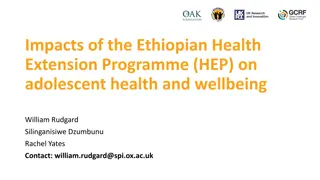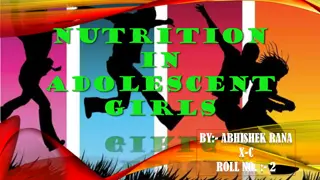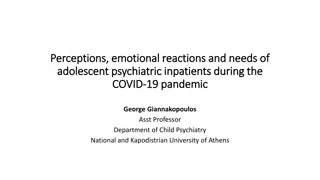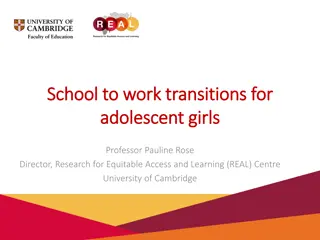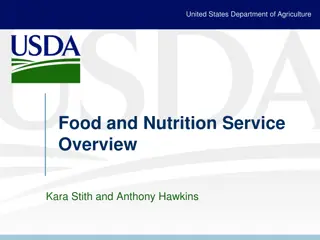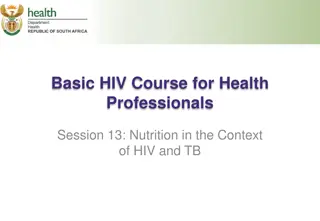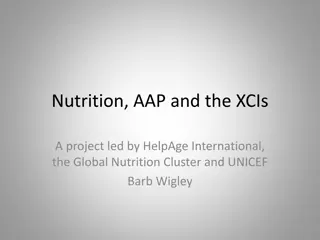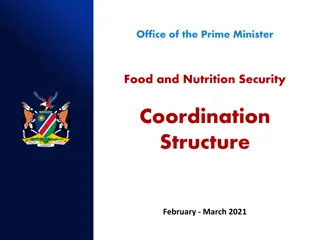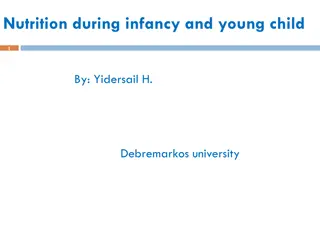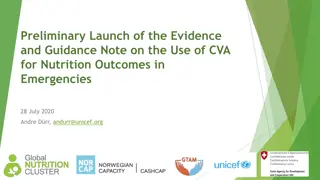Challenges of Adolescent Nutrition: Addressing Concerns and Solutions
Adolescents, especially girls, face numerous challenges in maintaining proper nutrition due to societal pressures and lifestyle choices. Lack of essential nutrients like calcium and Vitamin D, coupled with unhealthy eating habits, can lead to long-term health issues. Addressing these concerns is crucial to promoting overall well-being and preventing future health complications.
Download Presentation

Please find below an Image/Link to download the presentation.
The content on the website is provided AS IS for your information and personal use only. It may not be sold, licensed, or shared on other websites without obtaining consent from the author. Download presentation by click this link. If you encounter any issues during the download, it is possible that the publisher has removed the file from their server.
E N D
Presentation Transcript
Class X-B Teacher In charge-Ms. Charu Arora Ramjas School, R.K. Puram
Topics Definitions Nutrition in Adolescent girls Nutrition in Sportswomen Food Guidelines in India Food Guidelines in UK
Definitions 1.NUTRITION: It is a process through which the body gets the required nutrients from outside for the growth and maintenance of the state of order of our body. 2.ADOLESCENCE: The period of life, when the body undergoes changes, leading to reproductive maturity, is called adolescence. Adolescence begins around the age of 11 and lasts up to 18 or 19 years of age. Such children are called adolescents, or teens.
Nutrition in Adolescent Girls Nutrition in Adolescent Girls
Vulnerable Group- Exposed to variety of foods both good and bad for the body. Calculation: Nutrition is mainly calculated on the basis of daily intake of different nutrients in the body like calories, proteins, irons and minerals. Nutritional Requirements Nutrients Requirement for girls Calories 2200 Protein 0.8g/kg Calcium 1500 mg Fats 660 calories Iron 15 mg
Concerns In this lifestyle, adolescents hardly get required nutrition. Calcium: is a major concern. Only 20% of teen girls eat required calcium (recommended calcium requires 3 cups milk, 1 oz cheese, cup broccoli, 1 orange, 1 cup cereal per day). Vitamin D is also required to absorb this calcium. Soda intake: A lot of youngsters drink carbonated soda. These provide more calories than required and very less amount of other nutrients. Junk food: Several fast food joints provide teenagers with the option of eating more unhealthy foods rich in fats and carbohydrates. They also indulge in unhealthy eating due to peer pressure. Mindset: Girls often tend to be slim and thus try to eat less or lose more weight than they need to. In other cases, they may indulge in over-eating due to a variety of reasons.
Problems Eating unhealthily in adolescence can lead to problems throughout life. Some of these are: oDeficiency Diseases: Eating less than the required amount can cause several deficiency diseases such as xeropthalmia, night blindness, rickets, scurvy, and osteoporosis, which is seen especially in girls due to lack of Vitamin D and Calcium oObesity: Obesity can often result in several other ailments such as sleep apnea, Hepatic Steatosis, Orthopedic problems, high blood pressure and other cardiovascular diseases. oType 2 Diabetes: There is quite an increase in the instances of adolescents with type 2 diabetes. This leads to tremendous public health implications. oEating Disorders: Different habits may also cause eating disorders such as Anorexia Nervosa(excess dieting), Bulimia Nervosa(binge eating and purging) and binge eating disorder.
FACTORS INFLUENCING FOOD HABITS Various factors affect adolescent girls food habits: Psychological Influences: Early childhood experiences, exposure, genetics Eating healthy only a weak motivator Eating only junk food with friends, healthy at home Lifestyle: Sleep preferred more than breakfast Dining outside home Increasing fast food availability
Nutrition in Sportswomen Nutrition in Sportswomen
Role of Nutrition in sports Sports nutrition assumes critical importance because long before deficiency symptoms start appearing, physical performance declines. Attempts should be made to find out the level of nutrition below which physical performance starts showing changes. The level, which permits the athlete to achieve the maximum possible physical performance should be the minimum level aimed in sports nutrition. There is no perfect diet as nutritional requirements of various sportspersons depend on the sport, period of practice, athlete s preference etc. However, sound nutritional guidelines must be followed. To achieve optimal performance, it is important to maintain proper records of diets actually consumed by the players and changes in their body composition and physiological parameters in relation to performance. That would help in planning and combating malnutrition problems by modifying their diets time-to-time.
The energy requirement of an individual has been defined by WHO/FAO/UNU (1985) as the level of energy intake from food that will balance energy expenditure when the individual has a body size and composition, and level of physical activity, consistent with long term good health, and that will allow for maintenance of economically necessary and socially desirable physical activity . Although there are no international recommendations, many countries and WHO give similar recommendations for consumption of macronutrients, which are as follows (event category on next slide):
Nutrition for Female Athletes A Special Consideration The ideal diet is based on the woman s weight and consists of percentages of various food types proportional to that weight. In general, for female athletes, the recommended allowances for macronutrients are similar to those recommended for male counterparts. The macronutrient requirements can be worked out as follows: Carbohydrates: Take body weight in kilograms and then multiply it (her body weight) by 10. This gives the number of grams of carbohydrates in the diet. This makes carbohydrates about 70% of the woman s daily calories. An athlete s body needs more energy and the human body uses carbohydrates as its main fuel. Proteins: Proteins intake (grams) should be 1.0 to 1.5 times the body weight. This means 10-15% of calories come from protein, although some have raised this to 20-25%. Fat: About 20-30% of total calories should come from fat.
Care should be taken in the case of micronutrients especially iron and calcium, because of additional physiological demands of female athletes. In addition to iron and calcium the meals should be rich in vitamin B-12, folate, and zinc. Diets should include: 30 mg of iron, 800 to 1,200 mg of calcium and 1.3 mg of B-12 a day. Calcium needs can be met by 3 to 4 servings of low-fat milk, yogurt, or other calcium-rich foods. Calcium absorption requires adequate amount of protein, lactose (milk sugar), vitamin D and acidic foods. If red meat is not eaten, iron and B-12 supplements may be required. Iron from meat, poultry and fish are better absorbed by body than iron from plant sources. Vitamin C promotes the absorption of iron from plant sources. Tannins in tea and coffee hamper the absorption of iron from food and therefore, they should be taken in between meals and not along with meals. Soybeans can be added to the diet as they contains phytoestrogens, which research has shown can significantly lower bad (LDL) cholesterol and raise good (HDL) cholesterol.
Iron Deficiency Studies show that more than 50 percent of all women runners are deficient in iron. Sagging iron levels result in fatigue and poor endurance, since the blood is unable to carry oxygen as efficiently to working muscles. Feeling chilled or cold may be another sign that iron is low. Though losses of this important mineral occur during menstruation and in a few other small ways, lack of iron in the diet is the most likely cause of deficiency, as studies show that women distance runners usually get less than the RDA of 15 milligrams. Hemoglobin test, which measure the iron in blood, should be taken frequently to ensure proper level of iron in the body. Iron-rich foods, dietary supplements, and vitamin C (which helps absorb iron) should be included in their diets
A serious problem for female athletes is known as the female athlete triad. It is a shared relationship with eating disorders, menstrual problems, and stress fractures. It begins with severely restricted eating and intense workouts. These three issues are of growing concern, especially due to the increasing pressure on adolescent girls to maintain an ideal body weight. Female athletes need to feed their bodies well if they want to prevent the problems of the triad. They need to eat many, small, low fat meals. Small meals eaten often will stop hunger pangs, provide fuel and fluid for workouts, and increase the metabolic rate. They should eat five times a day, i.e. three meals and two snacks. Studies have shown that this helps in keeping the weight steady, improves memory, cognitive skill and work performance.
Recommendations By Indian Government Recommendations By Indian Government
In India, the primary institution for research and recommendations is the National Institute of Nutrition (NIN). The International Life Science Institute-India (ILSI India) also contributes to the research work. For recommending nutrition for sportspersons, the Sports Authority of India also intervenes. The major recommendations given by these institutes are: 1. The importance of nutrition in sports performance should be recognized and adequate facilities provided to ensure that athletes receive the right kind and amount of nutrition. 2. There should be periodical medical check up of athletes to assess changes in body weight, body composition, micronutrient balance, lipid profile, etc. in response to the diet and training. For this purpose each athlete should maintain his dietary history and training schedules and submit copies to the training institute. 3. Nutrition for female athletes is not very different from that or male athletes. But care has to be taken in respect of calcium and iron intake because of the additional physiological demands of female athletes. In addition, meals should be rich in B12, folate and zinc.
4. Diet has to be balanced in respect of macro nutrients and micronutrients. With balanced diet there is no need for food supplements. It is also found that excess of any nutrient, whether protein, iron, calcium, vitamins or any other, does not improve performance. 5. Fluid balance is critical. In heavy training exercises and events there is considerable loss of water in the body. This loss of water should be made up continuously. With the sweat there is also loss of electrolytes. Hence it is preferable that fluid balance is maintained from sports drinks which contain sodium chloride and potassium chloride. 6. Adolescents should be effectively intervened by behavioral intervention, appropriate strategies, and use of modern technology to raise awareness about adequate nutrition. 7. A check on the adolescents should be kept to know about their disorders, if any, and treat them. 8. A balanced diet should me prepared at home and eating outside should be discouraged as often as possible.
Recommendations By UK Government Recommendations By UK Government
The primary institutes in UK for conducting research related to nutrition is the NHS (National Health Service) They recommend the following: 1. Eating sugar or honey before an event doesn t provide energy as it takes them thirty minutes to enter the blood stream. 2. Excess protein should be avoided as it is stored as fat. 3. Consumption of fat shouldn t fall below 15% of total calorie intake as it may limit performance. 4. Athletes must take care of Vitamin B-12 as it cannot be gained from plant sources. It can be taken from non-vegetarian sources such as liver or milk. 5. All active women must pay special attention to iron and calcium in their daily intake. 6. People who require a lot of energy can get it from carbohydrate rich food.
1. Don't skip breakfast. Some people skip breakfast because they think it will help them lose weight. But skipping meals doesn't help you lose weight and is not good for you, because you can miss out on essential nutrients. 2. Aim to eat at least five portions of a variety of fruits and vegetables a day. They are good sources of many of the vitamins and minerals your body needs. 3. At snack time, swap foods that are high in saturated fat or sugars for healthier choices. Both saturated fat and sugar are high in calories, so if you eat these foods often you're more likely to become overweight. 4. Make sure you drink enough fluids. Aim to drink six to eight glasses of fluids a day: water, unsweetened fruit juices (diluted with water) and milk are all healthy choices.
1. 2. www.iloveindia.com 3. www.ilsi-india.org 4. www.ext.colostate.edu 5. www.google.com 6. www.wikipedia.org 7. www.agritech.tnau.ac.in 8. www.rspharmchem.com 9. www.nhs.uk 10. www.images.google.com www.nutritionist-resource.org.uk
There are several things that we learnt from this project. We learnt the importance of an adequate diet in our life. As life goes in the fast lane, we also need to get buckled up and be prepared for any problem. This project helped us understand several problems related to nutrition and the difference between an average girl and a sportswoman. It has helped improve our analytical skills by analyzing the various nutritional requirements in UK and India. It is interesting to find that both the governments stress upon calcium and water intake in case of sportswomen. Also both, though restricting high intake of fats have classified it as an essential nutrient without which the body will not perform at its best. We have also learnt about the daily nourishment which has encouraged us to find the nutritional details of our meal before having it. Thus we have been encouraged to lead a fitter and healthier life.



